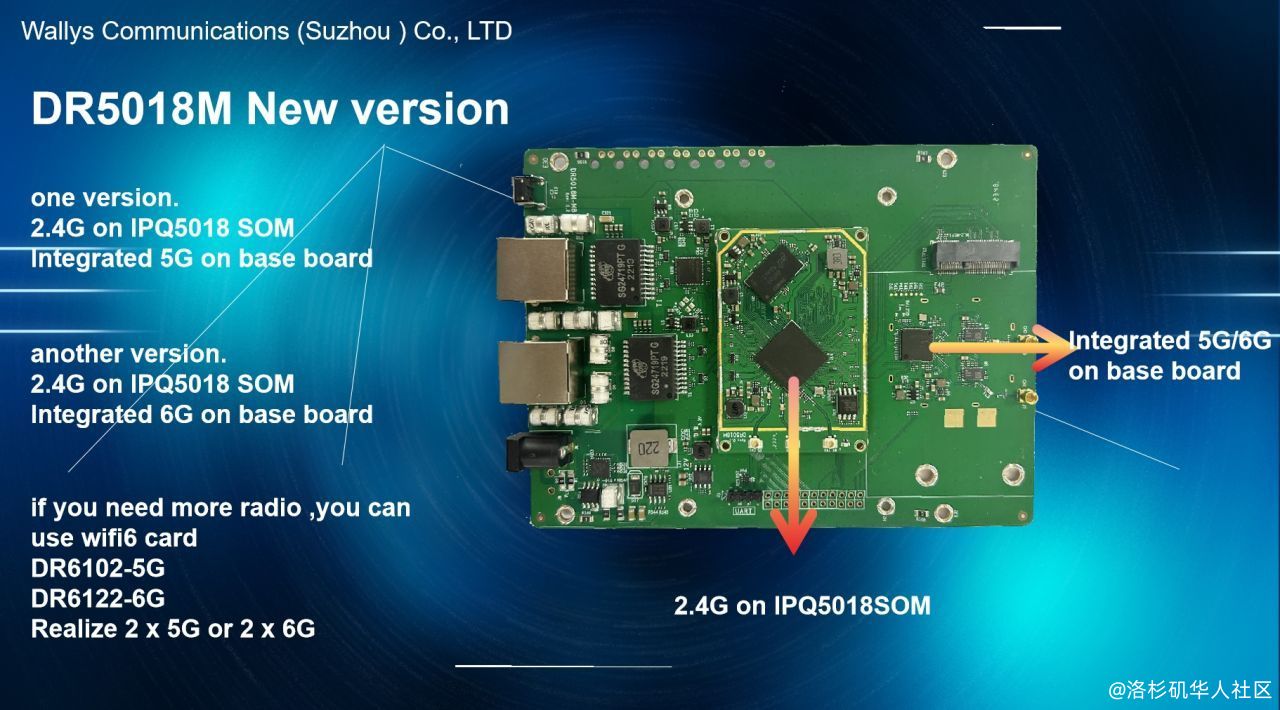Comparative Analysis of Wi-Fi 6 IPQ5018 and Wi-Fi 7 IPQ5332 Chips for Long-Distance Transmission Performance
The rapid advancement of Wi-Fi technology has significantly improved wireless network speed and coverage. Currently, both Wi-Fi 6 and the upcoming Wi-Fi 7 chips offer distinct advantages. This article will compare and analyze the long-distance transmission performance of the Wi-Fi 6 chip IPQ5018 and the Wi-Fi 7 chip IPQ5332 in the 5GHz and 6GHz bands based on MCS (Modulation and Coding Scheme) values.
Introduction to MCS (Modulation and Coding Scheme)
MCS (Modulation and Coding Scheme) is a crucial parameter for measuring wireless network transmission performance. Higher MCS values correspond to higher data transmission rates but also require better signal quality. Therefore, at longer distances or in weaker signal conditions, the effectiveness of high MCS values is limited.
Comparison of IPQ5018 (Wi-Fi 6) and IPQ5332 (Wi-Fi 7) Chip Parameters
| Datarate | IPQ5018 (Wi-Fi 6 5G) | IPQ5018 (Wi-Fi 6 6G) | IPQ5332 (Wi-Fi 7 5G) | IPQ5332 (Wi-Fi 7 6G) |
|---|---|---|---|---|
| MCS0 | 144 | 144 | 144 | 144 |
| MCS1 | 288 | 288 | 288 | 288 |
| MCS2 | 432 | 432 | 432 | 432 |
| MCS3 | 564 | 564 | 564 | 564 |
| MCS4 | 864 | 864 | 864 | 864 |
| MCS5 | 1152 | 1152 | 1152 | 1152 |
| MCS6 | 1298 | 1298 | 1298 | 1298 |
| MCS7 | 1442 | 1442 | 1442 | 1442 |
| MCS8 | 1730 | 1730 | 1730 | 1730 |
| MCS9 | 1922 | 1922 | 1922 | 1922 |
| MCS10 | 2162 | 2162 | 2162 | 2162 |
| MCS11 | 2402 | 2402 | 2402 | 2402 |
| MCS12 | 2594 | 2594 | ||
| MCS13 | 2882 | 2882 |
Frequency Bands and Transmission Distance
Wi-Fi transmission distance and signal penetration capabilities are closely related to frequency bands. Lower frequency bands (like 2.4GHz) have better penetration and coverage but lower speeds, while higher frequency bands (like 5GHz and 6GHz) offer higher speeds but poorer penetration. The 6GHz band, widely used in Wi-Fi 6E and Wi-Fi 7, provides more spectrum resources and higher transmission rates.
Long-Distance Transmission Performance Comparison
From the MCS table, it is clear that IPQ5018 and IPQ5332 have similar values from MCS0 to MCS11. This means that under the same modulation and coding scheme, Wi-Fi 6 and Wi-Fi 7 chips have comparable speed performance for long-distance transmission.
However, as a Wi-Fi 7 chip, IPQ5332 includes MCS12 and MCS13, which can provide higher transmission rates under ideal signal conditions. This is crucial for scenarios requiring extremely high data rates, such as ultra-high-definition streaming and virtual reality.
Nevertheless, in practical applications, long-distance transmission usually relies on lower MCS values since high MCS values require stronger signal quality and less interference. Therefore, the performance of IPQ5018 in long-distance transmission is essentially equivalent to that of IPQ5332.
Cost Advantage
As a Wi-Fi 6 chip, IPQ5018 has a significant cost advantage. For most households, businesses, and even some industrial applications, Wi-Fi 6 already offers sufficient speed and coverage, and the more affordable price of IPQ5018 makes it a highly cost-effective choice.
Conclusion
In summary, while the IPQ5332 as a Wi-Fi 7 chip offers higher transmission rates at higher MCS values, the IPQ5018 performs similarly in practical long-distance transmission scenarios and is more cost-effective. Therefore, for users needing stable long-distance wireless connections, the IPQ5018 is a highly attractive option, even suitable for most household, business, and some industrial applications, whereas the IPQ5332 is ideal for specific scenarios requiring ultra-high speeds.
Introducing the Wallys DR5018M
In response to market demand, the Wallys DR5018M development board has emerged. We made strategic improvements: adding performance enhancements over the previous DR6018 product while reducing the price. This makes the DR5018M an excellent choice for those seeking high performance at a lower cost.
For more information, please visit the Wallys DR5018M product page.




































